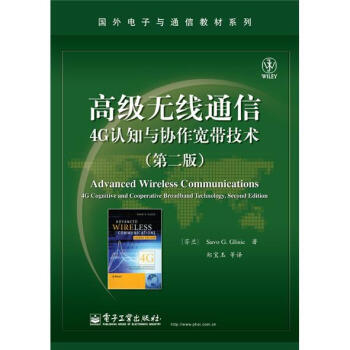![數字集成電路設計:從VLSI體係結構到CMOS製造(英文版) [Digital Integrated Circuit Design From VLSI Architectures to CMOS Fabrication]](https://pic.qciss.net/10064342/6c40497e-022b-40f4-afa7-62725243fd5d.jpg)

具體描述
編輯推薦
今天,集成電路設計技術高速發展,在各個領域得到廣泛應用,已經成為一種橫跨多學科的技術。《數字集成電路設計:從VLSI體係結構到CMOS製造(英文版)》從架構與算法講起,介紹瞭功能驗證、VHDL建模、同步電路設計、異步數據獲取、能耗與散熱、信號完整性、物理設計、設計驗證等必備技術,還講解瞭VLSI經濟與項目管理,並簡單闡釋瞭CMOS技術的基礎知識,全麵覆蓋瞭數字集成電路的整個設計開發過程。作為一本教科書,《數字集成電路設計:從VLSI體係結構到CMOS製造(英文版)》嚮工程專業學生展示瞭數字VLSl設計之美。揭示瞭各種技術難點,使他們避免重復前人的錯誤;作為一本技術參考書,《數字集成電路設計:從VLSI體係結構到CMOS製造(英文版)》內容全麵,豐富的錶格、清單、電路圖和個案研究能夠幫助正在開發硬件電路的在職工程師更好地完成自己的設計。
《數字集成電路設計:從VLSI體係結構到CMOS製造(英文版)》特點
·涵蓋瞭數字VLSI設計的大部分問題
·從算法設計到晶圓生産,以自頂嚮下方式一一講述
·重點闡釋瞭流行的CMOS技術和靜態電路
·全麵覆蓋數字VLSI設計者需要知道的半導體物理知識
·圖文並茂,深度體現課堂教學和實際設計項目驗證的思想
內容簡介
《數字集成電路設計:從VLSI體係結構到CMOS製造(英文版)》從架構與算法講起,介紹瞭功能驗證、VHDL建模、同步電路設計、異步數據獲取、能耗與散熱、信號完整性、物理設計、設計驗證等必備技術,還講解瞭VLSI經濟運作與項目管理,並簡單闡釋瞭CMOS技術的基礎知識,全麵覆蓋瞭數字集成電路的整個設計開發過程。《數字集成電路設計:從VLSI體係結構到CMOS製造(英文版)》既可作為高等院校微電子、電子技術等相關專業高年級師生和研究生的參考教材,也可供半導體行業工程師參考。
作者簡介
Hubert Kaeslin,1985年於瑞士蘇黎世聯邦理工學院獲得博士學位,現為該校微電子設計中心的負責人,具有20多年教授VLSI的豐富經驗。內頁插圖
目錄
Chapter 1 Introduction to Microelectronics 11.1 Economic impact 1
1.2 Concepts and terminology 4
1.2.1 The Guinness book of records point of view 4
1.2.2 The marketing point of view 5
1.2.3 The fabrication point of view 6
1.2.4 The design engineers point of view 10
1.2.5 The business point of view 17
1.3 Design flow in digital VLSI 18
1.3.1 The Y-chart, a map of digital electronic systems 18
1.3.2 Major stages in VLSI design 19
1.3.3 Cell libraries 28
1.3.4 Electronic design automation software 29
1.4 Field-programmable logic 30
1.4.1 Configuration technologies 30
1.4.2 Organization of hardware resources 32
1.4.3 Commercial products 35
1.5 Problems 37
1.6 Appendix I: A brief glossary of logic families 38
1.7 Appendix II: An illustrated glossary of circuit-related terms 40
Chapter 2 From Algorithms to Architectures 44
2.1 The goals of architecture design 44
2.1.1 Agenda 45
2.2 The architectural antipodes 45
2.2.1 What makes an algorithm suitable for a dedicated VLSI architecture? 50
2.2.2 There is plenty of land between the architectural antipodes 53
2.2.3 Assemblies of general-purpose and dedicated processing units 54
2.2.4 Coprocessors 55
2.2.5 Application-specific instruction set processors 55
2.2.6 Configurable computing 58
2.2.7 Extendable instruction set processors 59
2.2.8 Digest 60
2.3 A transform approach to VLSI architecture design 61
2.3.1 There is room for remodelling in the algorithmic domain 62
2.3.2 ...and there is room in the architectural domain 64
2.3.3 Systems engineers and VLSI designers must collaborate 64
2.3.4 A graph-based formalism for describing processing algorithms 65
2.3.5 The isomorphic architecture 66
2.3.6 Relative merits of architectural alternatives 67
2.3.7 Computation cycle versus clock period 69
2.4 Equivalence transforms for combinational computations 70
2.4.1 Common assumptions 71
2.4.2 Iterative decomposition 72
2.4.3 Pipelining 75
2.4.4 Replication 79
2.4.5 Time sharing 81
2.4.6 Associativity transform 86
2.4.7 Other algebraic transforms 87
2.4.8 Digest 87
2.5 Options for temporary storage of data 89
2.5.1 Data access patterns 89
2.5.2 Available memory configurations and area occupation 89
2.5.3 Storage capacities 90
2.5.4 Wiring and the costs of going off-chip 91
2.5.5 Latency and timing 91
2.5.6 Digest 92
2.6 Equivalence transforms for nonrecursive computations 93
2.6.1 Retiming 94
2.6.2 Pipelining revisited 95
2.6.3 Systolic conversion 97
2.6.4 Iterative decomposition and time-sharing revisited 98
2.6.5 Replication revisited 98
2.6.6 Digest 99
2.7 Equivalence transforms for recursive computations 99
2.7.1 The feedback bottleneck 100
2.7.2 Unfolding of first-order loops 101
2.7.3 Higher-order loops 103
2.7.4 Time-variant loops 105
2.7.5 Nonlinear or general loops 106
2.7.6 Pipeline interleaving is not an equivalence transform 109
2.7.7 Digest 111
2.8 Generalizations of the transform approach 112
2.8.1 Generalization to other levels of detail 112
2.8.2 Bit-serial architectures 113
2.8.3 Distributed arithmetic 116
2.8.4 Generalization to other algebraic structures 118
2.8.5 Digest 121
2.9 Conclusions 122
2.9.1 Summary 122
2.9.2 The grand architectural alternatives from an energy point of view 124
2.9.3 A guide to evaluating architectural alternatives 126
2.10 Problems 128
2.11 Appendix I: A brief glossary of algebraic structures 130
2.12 Appendix II: Area and delay figures of VLSI subfunctions 133
Chapter 3 Functional Verification 136
3.1 How to establish valid functional specifications 137
3.1.1 Formal specification 138
3.1.2 Rapid prototyping 138
3.2 Developing an adequate simulation strategy 139
3.2.1 What does it take to uncover a design flaw during simulation? 139
3.2.2 Stimulation and response checking must occur automatically 140
3.2.3 Exhaustive verification remains an elusive goal 142
3.2.4 All partial verification techniques have their pitfalls 143
3.2.5 Collecting test cases from multiple sources helps 150
3.2.6 Assertion-based verification helps 150
3.2.7 Separating test development from circuit design helps 151
3.2.8 Virtual prototypes help to generate expected responses 153
3.3 Reusing the same functional gauge throughout the entire design cycle 153
3.3.1 Alternative ways to handle stimuli and expected responses 155
3.3.2 Modular testbench design 156
3.3.3 A well-defined schedule for stimuli and responses 156
3.3.4 Trimming run times by skipping redundant simulation sequences 159
3.3.5 Abstracting to higher-level transactions on higher-level data 160
3.3.6 Absorbing latency variations across multiple circuit models 164
3.4 Conclusions 166
3.5 Problems 168
3.6 Appendix I: Formal approaches to functional verification 170
3.7 Appendix II: Deriving a coherent schedule for simulation and test 171
Chapter 4 Modelling Hardware with VHDL 175
4.1 Motivation 175
4.1.1 Why hardware synthesis? 175
4.1.2 What are the alternatives to VHDL? 176
4.1.3 What are the origins and aspirations of the IEEE 1076 standard? 176
4.1.4 Why bother learning hardware description languages? 179
4.1.5 Agenda 180
4.2 Key concepts and constructs of VHDL 180
4.2.1 Circuit hierarchy and connectivity 181
4.2.2 Concurrent processes and process interaction 185
4.2.3 A discrete replacement for electrical signals 192
4.2.4 An event-based concept of time for governing simulation 200
4.2.5 Facilities for model parametrization 211
4.2.6 Concepts borrowed from programming languages 216
4.3 Putting VHDL to service for hardware synthesis 223
4.3.1 Synthesis overview 223
4.3.2 Data types 224
4.3.3 Registers, finite state machines, and other sequential subcircuits 225
4.3.4 RAMs, ROMs, and other macrocells 231
4.3.5 Circuits that must be controlled at the netlist level 233
4.3.6 Timing constraints 234
4.3.7 Limitations and caveats for synthesis 238
4.3.8 How to establish a register transfer-level model step by step 238
4.4 Putting VHDL to service for hardware simulation 242
4.4.1 Ingredients of digital simulation 242
4.4.2 Anatomy of a generic testbench 242
4.4.3 Adapting to a design problem at hand 245
4.4.4 The VITAL modelling standard IEEE 1076.4 245
4.5 Conclusions 247
4.6 Problems 248
4.7 Appendix I: Books and Web Pages on VHDL 250
4.8 Appendix II: Related extensions and standards 251
4.8.1 Protected shared variables IEEE 1076a 251
4.8.2 The analog and mixed-signal extension IEEE 1076.1 252
4.8.3 Mathematical packages for real and complex numbers IEEE 1076.2 253
4.8.4 The arithmetic packages IEEE 1076.3 254
4.8.5 A language subset earmarked for synthesis IEEE 1076.6 254
4.8.6 The standard delay format (SDF) IEEE 1497 254
4.8.7 A handy compilation of type conversion functions 255
4.9 Appendix III: Examples of VHDL models 256
4.9.1 Combinational circuit models 256
4.9.2 Mealy, Moore, and Medvedev machines 261
4.9.3 State reduction and state encoding 268
4.9.4 Simulation testbenches 270
4.9.5 Working with VHDL tools from different vendors 285
Chapter 5 The Case for Synchronous Design 286
5.1 Introduction 286
5.2 The grand alternatives for regulating state changes 287
5.2.1 Synchronous clocking 287
5.2.2 Asynchronous clocking 288
5.2.3 Self-timed clocking 288
5.3 Why a rigorous approach to clocking is essential in VLSI 290
5.3.1 The perils of hazards 290
5.3.2 The pros and cons of synchronous clocking 291
5.3.3 Clock-as-clock-can is not an option in VLSI 293
5.3.4 Fully self-timed clocking is not normally an option either 294
5.3.5 Hybrid approaches to system clocking 294
5.4 The dos and don’ts of synchronous circuit design 296
5.4.1 First guiding principle: Dissociate signal classes! 296
5.4.2 Second guiding principle: Allow circuits to settle before clocking! 298
5.4.3 Synchronous design rules at a more detailed level 298
5.5 Conclusions 306
5.6 Problems 306
5.7 Appendix: On identifying signals 307
5.7.1 Signal class 307
5.7.2 Active level 308
5.7.3 Signaling waveforms 309
5.7.4 Three-state capability 311
5.7.5 Inputs, outputs, and bidirectional terminals 311
5.7.6 Present state vs. next state 312
5.7.7 Syntactical conventions 312
5.7.8 A note on upper- and lower-case letters in VHDL 313
5.7.9 A note on the portability of names across EDA platforms 314
Chapter 6 Clocking of Synchronous Circuits 315
6.1 What is the difficulty in clock distribution? 315
6.1.1 Agenda 316
6.1.2 Timing quantities related to clock distribution 317
6.2 How much skew and jitter does a circuit tolerate? 317
6.2.1 Basics 317
6.2.2 Single-edge-triggered one-phase clocking 319
6.2.3 Dual-edge-triggered one-phase clocking 326
6.2.4 Symmetric level-sensitive two-phase clocking 327
6.2.5 Unsymmetric level-sensitive two-phase clocking 331
6.2.6 Single-wire level-sensitive two-phase clocking 334
6.2.7 Level-sensitive one-phase clocking and wave pipelining 336
6.3 How to keep clock skew within tight bounds 339
6.3.1 Clock waveforms 339
6.3.2 Collective clock buffers 340
6.3.3 Distributed clock buffer trees 343
6.3.4 Hybrid clock distribution networks 344
6.3.5 Clock skew analysis 345
6.4 How to achieve friendly input/output timing 346
6.4.1 Friendly as opposed to unfriendly I/O timing 346
6.4.2 Impact of clock distribution delay on I/O timing 347
6.4.3 Impact of PTV variations on I/O timing 349
6.4.4 Registered inputs and outputs 350
6.4.5 Adding artificial contamination delay to data inputs 350
6.4.6 Driving input registers from an early clock 351
6.4.7 Tapping a domain’s clock from the slowest component therein 351
6.4.8 “Zero-delay” clock distribution by way of a DLL or PLL 352
6.5 How to implement clock gating properly 353
6.5.1 Traditional feedback-type registers with enable 353
6.5.2 A crude and unsafe approach to clock gating 354
6.5.3 A simple clock gating scheme that may work under certain conditions 355
6.5.4 Safe clock gating schemes 355
6.6 Summary 357
6.7 Problems 361
Chapter 7 Acquisition of Asynchronous Data 364
7.1 Motivation 364
7.2 The data consistency problem of vectored acquisition 366
7.2.1 Plain bit-parallel synchronization 366
7.2.2 Unit-distance coding 367
7.2.3 Suppression of crossover patterns 368
7.2.4 Handshaking 369
7.2.5 Partial handshaking 371
7.3 The data consistency problem of scalar acquisition 373
7.3.1 No synchronization whatsoever 373
7.3.2 Synchronization at multiple places 373
7.3.3 Synchronization at a single place 373
7.3.4 Synchronization from a slow clock 374
7.4 Metastable synchronizer behavior 374
7.4.1 Marginal triggering and how it becomes manifest 374
7.4.2 Repercussions on circuit functioning 378
7.4.3 A statistical model for estimating synchronizer reliability 379
7.4.4 Plesiochronous interfaces 381
7.4.5 Containment of metastable behavior 381
7.5 Summary 384
7.6 Problems 384
Chapter 8 Gate- and Transistor-Level Design 386
8.1 CMOS logic gates 386
8.1.1 The MOSFET as a switch 387
8.1.2 The inverter 388
8.1.3 Simple CMOS gates 396
8.1.4 Composite or complex gates 399
8.1.5 Gates with high-impedance capabilities 403
8.1.6 Parity gates 406
8.1.7 Adder slices 407
8.2 CMOS bistables 409
8.2.1 Latches 410
8.2.2 Function latches 412
8.2.3 Single-edge-triggered flip-flops 413
8.2.4 The mother of all flip-flops 415
8.2.5 Dual-edge-triggered flip-flops 417
8.2.6 Digest 418
8.3 CMOS on-chip memories 418
8.3.1 Static RAM 418
8.3.2 Dynamic RAM 423
8.3.3 Other differences and commonalities 424
8.4 Electrical CMOS contraptions 425
8.4.1 Snapper 425
8.4.2 Schmitt trigger 426
8.4.3 Tie-off cells 427
8.4.4 Filler cell or fillcap 428
8.4.5 Level shifters and input/output buffers 429
8.4.6 Digitally adjustable delay lines 429
8.5 Pitfalls 430
8.5.1 Busses and three-state nodes 430
8.5.2 Transmission gates and other bidirectional components 434
8.5.3 What do we mean by safe design? 437
8.5.4 Microprocessor interface circuits 438
8.5.5 Mechanical contacts 440
8.5.6 Conclusions 440
8.6 Problems 442
8.7 Appendix I: Summary on electrical MOSFET models 445
8.7.1 Naming and counting conventions 445
8.7.2 The Sah model 446
8.7.3 The Shichman–Hodges model 450
8.7.4 The alpha-power-law model 450
8.7.5 Second-order effects 452
8.7.6 Effects not normally captured by transistor models 455
8.7.7 Conclusions 456
8.8 Appendix II: The Bipolar Junction Transistor 457
Chapter 9 Energy Efficiency and Heat Removal 459
9.1 What does energy get dissipated for in CMOS circuits? 459
9.1.1 Charging and discharging of capacitive loads 460
9.1.2 Crossover currents 465
9.1.3 Resistive loads 467
9.1.4 Leakage currents 468
9.1.5 Total energy dissipation 470
9.1.6 CMOS voltage scaling 471
9.2 How to improve energy efficiency 474
9.2.1 General guidelines 474
9.2.2 How to reduce dynamic dissipation 476
9.2.3 How to counteract leakage 482
9.3 Heat flow and heat removal 488
9.4 Appendix I: Contributions to node capacitance 490
9.5 Appendix II: Unorthodox approaches 491
9.5.1 Subthreshold logic 491
9.5.2 Voltage-swing-reduction techniques 492
9.5.3 Adiabatic logic 492
Chapter 10 Signal Integrity 495
10.1 Introduction 495
10.1.1 How does noise enter electronic circuits? 495
10.1.2 How does noise affect digital circuits? 496
10.1.3 Agenda 499
10.2 Crosstalk 499
10.3 Ground bounce and supply droop 499
10.3.1 Coupling mechanisms due to common series impedances 499
10.3.2 Where do large switching currents originate? 501
10.3.3 How severe is the impact of ground bounce? 501
10.4 How to mitigate ground bounce 504
10.4.1 Reduce effective series impedances 505
10.4.2 Separate polluters from potential victims 510
10.4.3 Avoid excessive switching currents 513
10.4.4 Safeguard noise margins 517
10.5 Conclusions 519
10.6 Problems 519
10.7 Appendix: Derivation of second-order approximation 521
Chapter 11 Physical Design 523
11.1 Agenda 523
11.2 Conducting layers and their characteristics 523
11.2.1 Geometric properties and layout rules 523
11.2.2 Electrical properties 527
11.2.3 Connecting between layers 527
11.2.4 Typical roles of conducting layers 529
11.3 Cell-based back-end design 531
11.3.1 Floorplanning 531
11.3.2 Identify major building blocks and clock domains 532
11.3.3 Establish a pin budget 533
11.3.4 Find a relative arrangement of all major building blocks 534
11.3.5 Plan power, clock, and signal distribution 535
11.3.6 Place and route (P&R;) 538
11.3.7 Chip assembly 539
11.4 Packaging 540
11.4.1 Wafer sorting 543
11.4.2 Wafer testing 543
11.4.3 Backgrinding and singulation 544
11.4.4 Encapsulation 544
11.4.5 Final testing and binning 544
11.4.6 Bonding diagram and bonding rules 545
11.4.7 Advanced packaging techniques 546
11.4.8 Selecting a packaging technique 551
11.5 Layout at the detail level 551
11.5.1 Objectives of manual layout design 552
11.5.2 Layout design is no WYSIWYG business 552
11.5.3 Standard cell layout 556
11.5.4 Sea-of-gates macro layout 559
11.5.5 SRAM cell layout 559
11.5.6 Lithography-friendly layouts help improve fabrication yield 561
11.5.7 The mesh, a highly efficient and popular layout arrangement 562
11.6 Preventing electrical overstress 562
11.6.1 Electromigration 562
11.6.2 Electrostatic discharge 565
11.6.3 Latch-up 571
11.7 Problems 575
11.8 Appendix I: Geometric quantities advertized in VLSI 576
11.9 Appendix II: On coding diffusion areas in layout drawings 577
11.10 Appendix III: Sheet resistance 579
Chapter 12 Design Verification 581
12.1 Uncovering timing problems 581
12.1.1 What does simulation tell us about timing problems? 581
12.1.2 How does timing verification help? 585
12.2 How accurate are timing data? 587
12.2.1 Cell delays 588
12.2.2 Interconnect delays and layout parasitics 593
12.2.3 Making realistic assumptions is the point 597
12.3 More static verification techniques 598
12.3.1 Electrical rule check 598
12.3.2 Code inspection 599
12.4 Post-layout design verification 601
12.4.1 Design rule check 602
12.4.2 Manufacturability analysis 604
12.4.3 Layout extraction 605
12.4.4 Layout versus schematic 605
12.4.5 Equivalence checking 606
12.4.6 Post-layout timing verification 606
12.4.7 Power grid analysis 607
12.4.8 Signal integrity analysis 607
12.4.9 Post-layout simulations 607
12.4.10 The overall picture 607
12.5 Conclusions 608
12.6 Problems 609
12.7 Appendix I: Cell and library characterization 611
12.8 Appendix II: Equivalent circuits for interconnect modelling 612
Chapter 13 VLSI Economics and Project Management 615
13.1 Agenda 615
13.2 Models of industrial cooperation 617
13.2.1 Systems assembled from standard parts exclusively 617
13.2.2 Systems built around program-controlled processors 618
13.2.3 Systems designed on the basis of field-programmable logic 619
13.2.4 Systems designed on the basis of semi-custom ASICs 620
13.2.5 Systems designed on the basis of full-custom ASICs 622
13.3 Interfacing within the ASIC industry 623
13.3.1 Handoff points for IC design data 623
13.3.2 Scopes of IC manufacturing services 624
13.4 Virtual components 627
13.4.1 Copyright protection vs. customer information 627
13.4.2 Design reuse demands better quality and more thorough verification 628
13.4.3 Many existing virtual components need to be reworked 629
13.4.4 Virtual components require follow-up services 629
13.4.5 Indemnification provisions 630
13.4.6 Deliverables of a comprehensive VC package 630
13.4.7 Business models 631
13.5 The costs of integrated circuits 632
13.5.1 The impact of circuit size 633
13.5.2 The impact of the fabrication process 636
13.5.3 The impact of volume 638
13.5.4 The impact of configurability 639
13.5.5 Digest 640
13.6 Fabrication avenues for small quantities 642
13.6.1 Multi-project wafers 642
13.6.2 Multi-layer reticles 643
13.6.3 Electron beam lithography 643
13.6.4 Laser programming 643
13.6.5 Hardwired FPGAs and structured ASICs 644
13.6.6 Cost trading 644
13.7 The market side 645
13.7.1 Ingredients of commercial success 645
13.7.2 Commercialization stages and market priorities 646
13.7.3 Service versus product 649
13.7.4 Product grading 650
13.8 Making a choice 651
13.8.1 ASICs yes or no? 651
13.8.2 Which implementation technique should one adopt? 655
13.8.3 What if nothing is known for sure? 657
13.8.4 Can system houses afford to ignore microelectronics? 658
13.9 Keys to successful VLSI design 660
13.9.1 Project definition and marketing 660
13.9.2 Technical management 661
13.9.3 Engineering 662
13.9.4 Verification 665
13.9.5 Myths 665
13.10 Appendix: Doing business in microelectronics 667
13.10.1 Checklists for evaluating business partners and design kits 667
13.10.2 Virtual component providers 669
13.10.3 Selected low-volume providers 669
13.10.4 Cost estimation helps 669
Chapter 14 A Primer on CMOS Technology 671
14.1 The essence of MOS device physics 671
14.1.1 Energy bands and electrical conduction 671
14.1.2 Doping of semiconductor materials 672
14.1.3 Junctions, contacts, and diodes 674
14.1.4 MOSFETs 676
14.2 Basic CMOS fabrication flow 682
14.2.1 Key characteristics of CMOS technology 682
14.2.2 Front-end-of-line fabrication steps 685
14.2.3 Back-end-of-line fabrication steps 688
14.2.4 Process monitoring 689
14.2.5 Photolithography 689
14.3 Variations on the theme 697
14.3.1 Copper has replaced aluminum as interconnect material 697
14.3.2 Low-permittivity interlevel dielectrics are replacing silicon dioxide 698
14.3.3 High-permittivity gate dielectrics to replace silicon dioxide 699
14.3.4 Strained silicon and SiGe technology 701
14.3.5 Metal gates bound to come back 702
14.3.6 Silicon-on-insulator (SOI) technology 703
Chapter 15 Outlook 706
15.1 Evolution paths for CMOS technology 706
15.1.1 Classic device scaling 706
15.1.2 The search for new device topologies 709
15.1.3 Vertical integration 711
15.1.4 The search for better semiconductor materials 712
15.2 Is there life after CMOS? 714
15.2.1 Non-CMOS data storage 715
15.2.2 Non-CMOS data processing 716
15.3 Technology push 719
15.3.1 The so-called industry “laws” and the forces behind them 719
15.3.2 Industrial roadmaps 721
15.4 Market pull 723
15.5 Evolution paths for design methodology 724
15.5.1 The productivity problem 724
15.5.2 Fresh approaches to architecture design 727
15.6 Summary 729
15.7 Six grand challenges 730
15.8 Appendix: Non-semiconductor storage technologies for comparison 731
Appendix A Elementary Digital Electronics 732
A.1 Introduction 732
A.1.1 Common number representation schemes 732
A.1.2 Notational conventions for two-valued logic 734
A.2 Theoretical background of combinational logic 735
A.2.1 Truth table 735
A.2.2 The n-cube 736
A.2.3 Karnaugh map 736
A.2.4 Program code and other formal languages 736
A.2.5 Logic equations 737
A.2.6 Two-level logic 738
A.2.7 Multilevel logic 740
A.2.8 Symmetric and monotone functions 741
A.2.9 Threshold functions 741
A.2.10 Complete gate sets 742
A.2.11 Multi-output functions 742
A.2.12 Logic minimization 743
A.3 Circuit alternatives for implementing combinational logic 747
A.3.1 Random logic 747
A.3.2 Programmable logic array (PLA) 747
A.3.3 Read-only memory (ROM) 749
A.3.4 Array multiplier 749
A.3.5 Digest 750
A.4 Bistables and other memory circuits 751
A.4.1 Flip-flops or edge-triggered bistables 752
A.4.2 Latches or level-sensitive bistables 755
A.4.3 Unclocked bistables 756
A.4.4 Random access memories (RAMs) 760
A.5 Transient behavior of logic circuits 761
A.5.1 Glitches, a phenomenological perspective 762
A.5.2 Function hazards, a circuit-independent mechanism 763
A.5.3 Logic hazards, a circuit-dependent mechanism 764
A.5.4 Digest 765
A.6 Timing quantities 766
A.6.1 Delay quantities apply to combinational and sequential circuits 766
A.6.2 Timing conditions apply to sequential circuits only 768
A.6.3 Secondary timing quantities 770
A.6.4 Timing constraints address synthesis needs 771
A.7 Microprocessor input/output transfer protocols 771
A.8 Summary 773
Appendix B Finite State Machines 775
B.1 Abstract automata 775
B.1.1 Mealy machine 776
B.1.2 Moore machine 777
B.1.3 Medvedev machine 778
B.1.4 Relationships between finite state machine models 779
B.1.5 Taxonomy of finite state machines 782
B.1.6 State reduction 783
B.2 Practical aspects and implementation issues 785
B.2.1 Parasitic states and symbols 785
B.2.2 Mealy-, Moore-, Medvedev-type, and combinational output bits 787
B.2.3 Through paths and logic instability 787
B.2.4 Switching hazards 789
B.2.5 Hardware costs 790
B.3 Summary 793
Appendix C VLSI Designer’s Checklist 794
C.1 Design data sanity 794
C.2 Pre-synthesis design verification 794
C.3 Clocking 795
C.4 Gate-level considerations 796
C.5 Design for test 797
C.6 Electrical considerations 798
C.7 Pre-layout design verification 799
C.8 Physical considerations 800
C.9 Post-layout design verification 800
C.10 Preparation for testing of fabricated prototypes 801
C.11 Thermal considerations 802
C.12 Board-level operation and testing 802
C.13 Documentation 802
Appendix D Symbols and constants 804
D.1 Mathematical symbols used 804
D.2 Abbreviations 807
D.3 Physical and material constants 808
References 811
Index 832
精彩書摘
From Algorithms to Architectures2.1 The goals of architecture design
VLSI architecture design is concerned with deciding on the necessary hardware resources for solving problems from data and/or signal processing and with organizing their interplay in such a way as to meet target specifications defined by marketing. The foremost concern is to get the desired functionality right.The second priority is to meet some given performance target j often expressed in terms of data throughput or operation rate.A third objective,of economic nature this timej is to minimize production costs.Assuming a given fabrication process,this implies minimizing circuit size and maximizing fabrication yield SO as to obtain as many functioning parts per processed wafer as possible.
Another general concern in VLSI design is energy efficiency.Battery-operated equipment,such as hand-held cellular phones,laptop computers,digital hearing aids; etc.,obviously imposes stringent limits on the acceptable power consumption.It is perhaps less evident that energy efficiency is also of interest when power gets supplied from the mains.The reason for this is the cost of removing the heat generated by high.performance high-density ICs.While the VLSI designer is challenged to meet a given performance figure at minimum power in the former case,maximizing performance within a limited power budget is what is sought in the latter.
The ability to change from one mode of operation to another in very little time,and the flexibility to accommodate evolving needs and/or to upgrade to future standards are other highly desirable qualities and subsumed here under the term agility.Last but not least,two distinct architectures are likely to differ in terms of the overall engineering effort required to work them out in full detail and,hence also,in their respective times to market.
前言/序言
Why this book?Designing integrated electronics has become a multisciplinary enterprise that involves solving problems from fields as disparate as
·Hardware architecture
·Software engineering
·Marketing and investment
·Solid-state physics
·Systems engineering
·Circuit design
·Discrete mathematics
·Electronic design automation
·Layout design
·Hardware test equipment and measurement techniques
Covering all these subjects is clearly beyond the scope of this text and also beyond the authors proficiency.Yet,I have made an attempt to collect material from the above fields that I have found to be relevant for deciding whether or not to develop digital Very Large Scale Integration(VLSI) circuits,for making major design decisions,and for carrying out the actual engineering work. The present volume has been written with two audiences in mind.As a textbook.it wants to intro- duce engineering students to the beauty and the challenges of digital VLSI design while preventing them from repeating mistakes that others have made before.Practising electronics engineers should find it appealing as a reference book because of its comprehensiveness and the many tables,check- lists,diagrams,and case studies intended to help them not to overlook important action items and alternative options when planning to develop their own hardware components.
What sets this book apart from others in the field is its top-down approach.Beginning with hardware architectures,rather than with solid。state physics,naturally follows the normal VLSI design flow and makes the material more accessible to readers with a background in systems engineering, information technology,digital signal processing,or management.
用戶評價
一本真正讓我醍醐灌頂的工具書,雖然我並非科班齣身,但在接觸瞭這本書之後,我對電子世界的奧秘有瞭前所未有的清晰認識。它就像一位循循善誘的導師,將那些原本遙不可及的概念,比如VLSI的宏偉藍圖,以及CMOS製造背後精密的工藝流程,一點一點地拆解,以一種近乎藝術的方式呈現在我麵前。作者的敘述邏輯嚴謹,從宏觀的係統設計理念,深入到微觀的晶體管級彆,每一個環節的銜接都流暢自然,仿佛在我腦海中構建起一座立體的數字電路模型。我尤其欣賞書中對設計流程的細緻描述,從概念的萌芽,到架構的選取,再到邏輯的實現,最後到物理的布局布綫,每一個步驟都充滿瞭挑戰與智慧。即使是那些涉及物理化學的製造過程,作者也用生動形象的比喻,讓我這個非專業人士也能窺見其精妙之處,理解為何一個小小的芯片背後蘊藏著如此龐大的工程。這本書讓我意識到,數字集成電路設計絕不僅僅是枯燥的理論堆砌,而是一門融閤瞭科學、工程與藝術的學科,它需要深厚的理論基礎,也需要豐富的實踐經驗。我迫不及待地想將書中的知識應用到我的實際項目中,去創造屬於自己的數字世界。
評分坦白說,我抱著極大的期望來閱讀這本書,而它也確實沒有辜負我的期待。這本書最讓我印象深刻的是它對於“從概念到現實”這一過程的完整呈現。它不像市麵上許多教材那樣,隻專注於某一個特定的技術點,而是將VLSI設計與CMOS製造這兩個看似獨立的領域,完美地融閤在一起,形成瞭一個有機的整體。作者在講解VLSI體係結構時,邏輯嚴謹,層次分明,讓我能夠清晰地理解從高層設計到底層實現的過程。無論是處理器架構的設計原則,還是數字信號處理的算法實現,書中的論述都深入淺齣,極具啓發性。而當進入CMOS製造的部分,我更是被作者的專業度和生動性所摺服。那些復雜的工藝流程,在作者的筆下變得易於理解,讓我看到瞭半導體工業背後令人驚嘆的精密與高效。這本書不僅僅是傳授知識,更重要的是它教會瞭我如何去思考,如何去解決問題,如何去欣賞工程師們在每一個細節上付齣的努力。
評分閱讀此書的體驗,簡直像是在一次穿越時空的旅行,從抽象的設計概念,一步步走嚮具象的物理實體。這本書的結構設計非常巧妙,它並沒有一開始就鑽入晦澀的細節,而是從宏觀的VLSI體係結構入手,為讀者勾勒齣集成電路設計的整體框架。這種由大到小的敘事方式,讓我能夠更好地理解各個組成部分之間的相互關係,以及它們如何協同工作以實現復雜的功能。當我沉浸在書中對各種處理器架構、內存係統以及通信接口的討論中時,我仿佛能看到那些工程師們是如何將無數的邏輯門巧妙地組閤在一起,構建齣強大的計算引擎。隨後,當話題轉嚮CMOS製造時,我的震撼更是無以復加。作者將那些納米級彆的精細工藝,如光刻、薄膜沉積、離子注入等,描述得如同發生在眼前一般。我從中體會到瞭人類智慧的極緻,以及工程技術所能達到的高度。這本書讓我深刻認識到,一枚小小的芯片,承載的是無數工程師的心血與汗水,是科技進步的結晶。
評分這是一本我願意反復翻閱的經典之作。它的價值遠不止於技術的傳授,更在於它所傳達的那種工程精神和科學嚴謹性。作者對於VLSI體係結構的剖析,精準而深刻,讓我能夠窺探到現代數字係統設計的核心思想。無論是對流水綫、超標量、多核等處理技術原理的闡述,還是對存儲器層次結構、總綫協議等係統級組件的講解,都充滿瞭智慧的光芒。每一次閱讀,都能發現新的理解。更令人驚喜的是,本書並沒有停留在理論層麵,而是將目光投嚮瞭CMOS製造的實際工藝。作者將那些在潔淨室中進行的、納米級彆的精密操作,描繪得清晰可見,讓我對芯片的誕生過程有瞭切實的感受。從晶圓的製備,到光刻、蝕刻、擴散等一係列復雜工序,再到最終的封裝測試,每一個環節都體現瞭人類科技的極緻。這本書讓我深刻體會到,每一個閃耀在科技前沿的電子設備,都離不開背後龐大而精密的工程體係。
評分翻開這本書,仿佛打開瞭一扇通往微觀宇宙的大門,讓我得以窺探那些塑造我們數字生活的基石。作者以一種旁徵博引、深入淺齣的方式,將復雜的VLSI設計理念娓娓道來,讓我對集成電路的整個生命周期都有瞭全新的認知。從最初的係統級架構設計,到具體的邏輯功能實現,再到最終的物理層麵的CMOS製造工藝,每一個環節都被剖析得淋灕盡緻。我尤其被書中對不同VLSI架構的比較分析所吸引,作者深入淺齣地解釋瞭各種架構的優劣勢,以及在不同應用場景下的選擇依據,這對於我理解現代處理器設計的發展脈絡非常有幫助。而關於CMOS製造工藝的部分,雖然涉及大量專業知識,但作者卻能用通俗易懂的語言,將那些微觀世界的奇妙景象呈現在我眼前,例如光刻、蝕刻、摻雜等工藝過程,不再是冰冷的術語,而是變成瞭生動的畫麵。這本書不僅僅是一本技術手冊,更像是一部關於創新與工程的史詩,它激發瞭我對這個領域的無限好奇心,讓我渴望進一步探索其深奧的魅力。
評分正版, 書不錯, 就是邊角有點磨瞭, 快遞服務態度也不錯
評分可以
評分加油
評分這種技術類的書,還是要看英文
評分可以
評分這種技術類的書,還是要看英文
評分書很好,超贊,適閤各種人
評分公司的師傅看瞭 說是很不錯
評分正版, 書不錯, 就是邊角有點磨瞭, 快遞服務態度也不錯
相關圖書
本站所有內容均為互聯網搜尋引擎提供的公開搜索信息,本站不存儲任何數據與內容,任何內容與數據均與本站無關,如有需要請聯繫相關搜索引擎包括但不限於百度,google,bing,sogou 等
© 2025 book.cndgn.com All Rights Reserved. 新城书站 版權所有




















